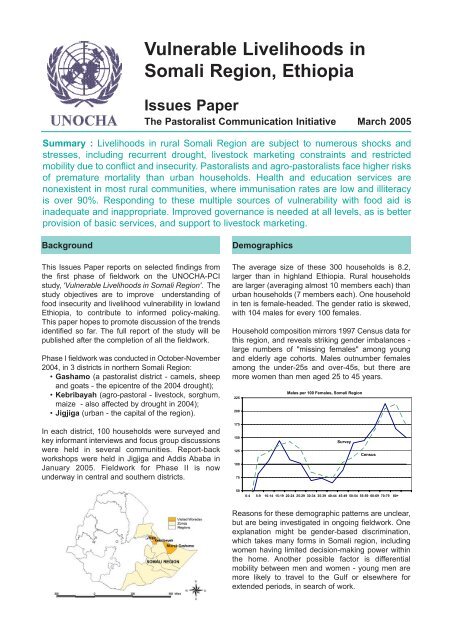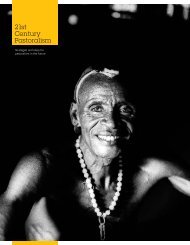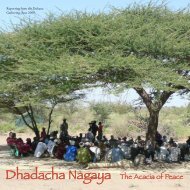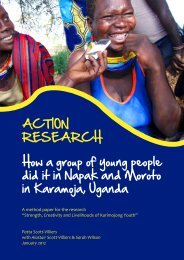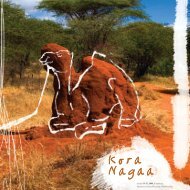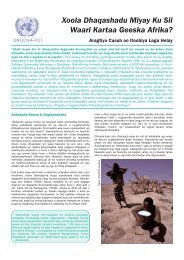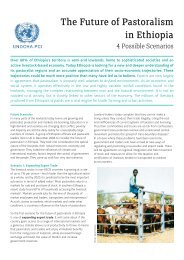Download PDF (212Kb) - the Website of the Pastoralist ...
Download PDF (212Kb) - the Website of the Pastoralist ...
Download PDF (212Kb) - the Website of the Pastoralist ...
You also want an ePaper? Increase the reach of your titles
YUMPU automatically turns print PDFs into web optimized ePapers that Google loves.
Vulnerable Livelihoods in<br />
Somali Region, Ethiopia<br />
Issues Paper<br />
The <strong>Pastoralist</strong> Communication Initiative March 2005<br />
Summary : Livelihoods in rural Somali Region are subject to numerous shocks and<br />
stresses, including recurrent drought, livestock marketing constraints and restricted<br />
mobility due to conflict and insecurity. <strong>Pastoralist</strong>s and agro-pastoralists face higher risks<br />
<strong>of</strong> premature mortality than urban households. Health and education services are<br />
nonexistent in most rural communities, where immunisation rates are low and illiteracy<br />
is over 90%. Responding to <strong>the</strong>se multiple sources <strong>of</strong> vulnerability with food aid is<br />
inadequate and inappropriate. Improved governance is needed at all levels, as is better<br />
provision <strong>of</strong> basic services, and support to livestock marketing.<br />
Background<br />
This Issues Paper reports on selected findings from<br />
<strong>the</strong> first phase <strong>of</strong> fieldwork on <strong>the</strong> UNOCHA-PCI<br />
study, 'Vulnerable Livelihoods in Somali Region'. The<br />
study objectives are to improve understanding <strong>of</strong><br />
food insecurity and livelihood vulnerability in lowland<br />
Ethiopia, to contribute to informed policy-making.<br />
This paper hopes to promote discussion <strong>of</strong> <strong>the</strong> trends<br />
identified so far. The full report <strong>of</strong> <strong>the</strong> study will be<br />
published after <strong>the</strong> completion <strong>of</strong> all <strong>the</strong> fieldwork.<br />
Phase I fieldwork was conducted in October-November<br />
2004, in 3 districts in nor<strong>the</strong>rn Somali Region:<br />
• Gashamo (a pastoralist district - camels, sheep<br />
and goats - <strong>the</strong> epicentre <strong>of</strong> <strong>the</strong> 2004 drought);<br />
• Kebribayah (agro-pastoral - livestock, sorghum,<br />
maize - also affected by drought in 2004);<br />
• Jigjiga (urban - <strong>the</strong> capital <strong>of</strong> <strong>the</strong> region).<br />
Demographics<br />
The average size <strong>of</strong> <strong>the</strong>se 300 households is 8.2,<br />
larger than in highland Ethiopia. Rural households<br />
are larger (averaging almost 10 members each) than<br />
urban households (7 members each). One household<br />
in ten is female-headed. The gender ratio is skewed,<br />
with 104 males for every 100 females.<br />
Household composition mirrors 1997 Census data for<br />
this region, and reveals striking gender imbalances -<br />
large numbers <strong>of</strong> "missing females" among young<br />
and elderly age cohorts. Males outnumber females<br />
among <strong>the</strong> under-25s and over-45s, but <strong>the</strong>re are<br />
more women than men aged 25 to 45 years.<br />
225<br />
200<br />
Males per 100 Females, Somali Region<br />
In each district, 100 households were surveyed and<br />
key informant interviews and focus group discussions<br />
were held in several communities. Report-back<br />
workshops were held in Jigjiga and Addis Ababa in<br />
January 2005. Fieldwork for Phase II is now<br />
underway in central and sou<strong>the</strong>rn districts.<br />
175<br />
150<br />
125<br />
100<br />
75<br />
Survey<br />
Census<br />
50<br />
0-4 5-9 10-14 15-19 20-24 25-29 30-34 35-39 40-44 45-49 50-54 55-59 60-69 70-79 80+<br />
Reasons for <strong>the</strong>se demographic patterns are unclear,<br />
but are being investigated in ongoing fieldwork. One<br />
explanation might be gender-based discrimination,<br />
which takes many forms in Somali region, including<br />
women having limited decision-making power within<br />
<strong>the</strong> home. Ano<strong>the</strong>r possible factor is differential<br />
mobility between men and women - young men are<br />
more likely to travel to <strong>the</strong> Gulf or elsewhere for<br />
extended periods, in search <strong>of</strong> work.
Vulnerable Livelihoods in Somali Region, Issues Paper, March 2005<br />
Health<br />
High health risks and poor access to health services<br />
are a major source <strong>of</strong> vulnerability, as is evident in<br />
mortality data from our household survey. In urban<br />
Jigjiga, death rates peak among <strong>the</strong> over 60s, but in<br />
Gashamo and Kebribayah life expectancy is lower,<br />
and most deaths occur among children under 5. A<br />
high proportion <strong>of</strong> <strong>the</strong>se deaths are preventable. The<br />
most common causes are illness and disease, but in<br />
rural areas much reported premature mortality is due<br />
to malnutrition or famine, violent conflict, accidents,<br />
and deaths in childbirth. In Jigjiga town, by contrast,<br />
no deaths were attributed to malnutrition or conflict.<br />
Number <strong>of</strong> Deaths<br />
40<br />
35<br />
30<br />
25<br />
20<br />
15<br />
10<br />
5<br />
0<br />
Age Structure <strong>of</strong> Deaths, by District<br />
0-1 1-4 5-9 10-19 20-29 30-39 40-59 60-79 80+<br />
Almost twice as many deaths were reported by rural<br />
households than urban, which must be at least partly<br />
due to differential access to health services. Over<br />
90% <strong>of</strong> rural households stated that <strong>the</strong>y have no<br />
access to health services, while this figure was only<br />
5% in Jigjiga town.<br />
Also in Jigjiga, 58% <strong>of</strong> children had been vaccinated,<br />
but in Gashamo <strong>the</strong> figure was 33%; and in<br />
Kebribayah, 19%. Rural respondents <strong>of</strong>ten reported<br />
going for treatment to Somaliland, because this is <strong>the</strong><br />
closest health facility available to <strong>the</strong>m and because<br />
<strong>the</strong> quality <strong>of</strong> treatment is better.<br />
Health services in Somali Region must be improved.<br />
Investment in health is vital for development, and lack<br />
<strong>of</strong> access to basic health care is costing lives. It is not<br />
good enough to argue that pastoralist communities<br />
cannot be reached with public services because <strong>the</strong>y<br />
are <strong>of</strong>ten on <strong>the</strong> move. As one respondent told us:<br />
"There are mobile teams that visit <strong>the</strong> communities for<br />
vaccinations, like 'National Immunisation Day', and <strong>the</strong><br />
'Campaign Against Polio'. There is also <strong>the</strong> 'Eye Mobile'."<br />
Education<br />
Age Cohort<br />
Gashamo<br />
Kebribayah<br />
Jigjiga<br />
Literacy in Somali region is low, but is much higher in<br />
urban areas than rural areas. In Jigjiga town, half <strong>the</strong><br />
population sampled can read and write, but in rural<br />
Gashamo and Kebribayah, literacy is only 7%, and<br />
93% <strong>of</strong> people surveyed have never been to school.<br />
The reasons appear to be a combination <strong>of</strong> demand<br />
constraints (poverty, costs <strong>of</strong> education), and supply<br />
constraints (lack <strong>of</strong> schools and qualified teachers).<br />
Many parents expressed strong interest in educating<br />
<strong>the</strong>ir children, and complained about lack <strong>of</strong> access to<br />
schools. In many rural communities, school buildings<br />
are known jokingly as "hyena schools", as <strong>the</strong>y <strong>of</strong>ten<br />
stand unused. The drought also disrupted available<br />
education services, as parents withdrew <strong>the</strong>ir children<br />
because <strong>of</strong> hunger and inability to pay <strong>the</strong> costs <strong>of</strong><br />
fees, uniforms and school materials.<br />
Education is vital if rural households in Somali Region<br />
are to have access to alternative livelihoods, should<br />
pastoralism become too difficult. Without functional<br />
literacy, people who are "pulled" or "pushed" to urban<br />
areas have little prospect <strong>of</strong> securing employment,<br />
apart from low-return unskilled activities such as<br />
collecting firewood or carrying water. In Jigjiga town,<br />
schooling is seen as important for learning English.<br />
Drought Impacts and Responses<br />
Three <strong>of</strong> <strong>the</strong> last five years have been drought years<br />
in Somali Region. The 2004 drought was especially<br />
severe in Gashamo District, where livestock died in<br />
large numbers. The local name for <strong>the</strong> drought was<br />
Tuur ku qaad ("carry on your shoulder"), a comment<br />
on <strong>the</strong> fact that so many pack animals, even camels,<br />
died.<br />
Three in four rural households said <strong>the</strong>y had suffered<br />
hunger during <strong>the</strong> drought. Most adults in Gashamo<br />
and Kebribayah reported cutting down to one meal<br />
per day, while adults in Jigjiga continued eating three<br />
Households (%)<br />
What people said about education:<br />
• "Our children are our assets and educating <strong>the</strong>m<br />
is our priority - but where are <strong>the</strong> schools?"<br />
• "There is no school here, only one Quranic<br />
school."<br />
• "Since <strong>the</strong> drought, teachers cannot teach due to<br />
hunger, and students can't attend school - also<br />
because <strong>of</strong> hunger."<br />
80<br />
70<br />
60<br />
50<br />
40<br />
30<br />
20<br />
10<br />
0<br />
Adult Meals per Day, 2004 (worst month)<br />
Gashamo<br />
Kebribayah<br />
Jigjiga<br />
0 1 2 3
Vulnerable Livelihoods in Somali Region, Issues Paper, March 2005<br />
meals daily. Parents protected <strong>the</strong>ir children from<br />
hunger by rationing <strong>the</strong>ir own food consumption more<br />
severely. Several people were displaced to urban<br />
areas. In Kebribayah one household divided "due to<br />
hunger", with <strong>the</strong> wife and children moving to Jigjiga<br />
until <strong>the</strong> crisis had passed.<br />
People emphasised that <strong>the</strong>y tried to help each o<strong>the</strong>r,<br />
but <strong>the</strong> severity <strong>of</strong> <strong>the</strong> drought undermined informal<br />
assistance. "Everyone in this community is at <strong>the</strong><br />
same level <strong>of</strong> income, so we couldn't help each o<strong>the</strong>r<br />
this year." In Gashamo, where 67% <strong>of</strong> households<br />
surveyed had paid zakaat contributions in 2003, only<br />
3% managed to pay in 2004. People in Kebribayah<br />
said receiving zakaat requires patronage connections<br />
to wealthier people: "Zakaat is for rich people and<br />
those who know <strong>the</strong>m; it is not for people like us."<br />
Food aid was distributed as a drought relief measure<br />
in 2003 and 2004. In Gashamo, 72% <strong>of</strong> households<br />
had received some food aid at least once in 2004. In<br />
Kebribayah, <strong>the</strong> figure was much lower, at 42%, and<br />
in Jigjiga, only 10%. No households had participated<br />
in food- or cash-for-work. Informal redistribution <strong>of</strong><br />
food aid at various levels reduced <strong>the</strong> food received<br />
by each household. One household <strong>of</strong> 3 adults and 6<br />
children was given 50kg <strong>of</strong> wheat as food aid in 2003,<br />
but only three cupfuls <strong>of</strong> wheat in 2004, about 1½ kg.<br />
Attitudes to food aid were more <strong>of</strong>ten negative than<br />
positive. Many people complained about receiving<br />
food aid in <strong>the</strong> form <strong>of</strong> wheat, which is unfamiliar and<br />
unpopular. Both pastoralists and agro-pastoralists<br />
suggested that food aid is an inappropriate and<br />
inadequate response to <strong>the</strong>ir problems, and that more<br />
sustainable forms <strong>of</strong> livelihood support are needed.<br />
What people said about food aid:<br />
• "We could not eat it because it was dry and hard<br />
to eat. So we gave it to our livestock."<br />
• "When <strong>the</strong> food aid reaches <strong>the</strong> elders <strong>the</strong>y take<br />
half <strong>of</strong> it and <strong>the</strong> rest disappears. We don't know<br />
where it goes."<br />
• "What we need is help with reconstructing <strong>the</strong><br />
livelihood we used to live, not food aid.<br />
Restocking, veterinary facilities, health care,<br />
employment opportunities, education for our<br />
children - that's what is important to us."<br />
Photo UNOCHA<br />
Conflict and Governance<br />
Conflict and insecurity impact in multiple ways on<br />
lives and livelihoods throughout rural Somali Region.<br />
A disaggregated analysis is needed to understand<br />
<strong>the</strong> legacy <strong>of</strong> past wars (displacement, rehabilitation,<br />
contested territory); ongoing conflicts between clans<br />
(over access to resources, or blood feuds); militia<br />
activity; border disputes (mainly with Oromiya);<br />
livestock raiding; small arms proliferation; and "aabsi"<br />
(fear <strong>of</strong> conflict or attack, which restricts pastoralists'<br />
mobility along unsafe migration routes).<br />
In 14 <strong>of</strong> 200 rural households surveyed (7%), one or<br />
more members had lost <strong>the</strong>ir lives in violent conflict.<br />
Inter-clan conflicts <strong>of</strong>ten occur over access to grazing<br />
land or water points. Recent violent episodes have<br />
caused loss <strong>of</strong> property, livestock and lives. Several<br />
trucks carrying food or livestock have been attacked.<br />
In Kebribayah, many disputes are over farming land.<br />
In one case, two sub-clans quarrelled over land that<br />
had belonged to <strong>the</strong> community and was allocated by<br />
<strong>the</strong> elders. Tensions ran high and a man was killed.<br />
Relations between <strong>the</strong> two sub-clans remain tense.<br />
Traditionally, conflict resolution has been <strong>the</strong> role <strong>of</strong><br />
clan elders. In Gashamo and Kebribayah, people still<br />
turn to <strong>the</strong> elders to resolve conflicts in most cases. In<br />
Jigjiga town, <strong>the</strong> police are more <strong>of</strong>ten approached to<br />
resolve disputes, ahead <strong>of</strong> <strong>the</strong> elders.<br />
There is widespread disillusionment with <strong>the</strong> ability <strong>of</strong><br />
government at any level to improve living conditions<br />
in Somali region. Over 70% <strong>of</strong> respondents in all 3<br />
districts felt <strong>the</strong>y were not fairly represented in local,<br />
regional or federal government structures, and over<br />
80% felt <strong>the</strong>ir representatives were not representing<br />
<strong>the</strong>ir interests effectively.<br />
What people said about government:<br />
• "No-one talks to us to ask what we need. The<br />
government does not exist here."<br />
• "What government are you talking about? We<br />
only see <strong>the</strong> army, if that's what you mean."<br />
• "We do not know if we have representation. It<br />
seems no-one is conveying our problems to <strong>the</strong><br />
government."
Vulnerable Livelihoods in Somali Region, Issues Paper, March 2005<br />
Livestock Marketing<br />
Contrary to stereotypical images <strong>of</strong> pastoralists as<br />
self-sufficient nomads who depend almost entirely on<br />
<strong>the</strong>ir animals for food (meat, milk and cheese, blood)<br />
pastoralists generally depend heavily on <strong>the</strong> market.<br />
They sell livestock for cereals, o<strong>the</strong>r food and various<br />
goods and services for which cash is needed. When<br />
livestock marketing channels are disrupted for any<br />
reason, this has impacts on <strong>the</strong>ir livelihoods that are<br />
potentially as damaging as severe drought or conflict.<br />
“Poverty Cycles” or “Poverty Rachets”?<br />
When asked to assess <strong>the</strong>ir well-being status over<br />
<strong>the</strong> past 10 years, <strong>the</strong> responses <strong>of</strong> pastoralists in<br />
Gashamo reflected a high degree <strong>of</strong> livelihood<br />
volatility. Most households said <strong>the</strong>y were doing well<br />
in <strong>the</strong> mid-1990s, but <strong>the</strong> drought <strong>of</strong> 1999/2000<br />
caused a steep rise in those who were 'struggling'.<br />
This was followed by 2-3 years <strong>of</strong> recovery, before<br />
<strong>the</strong> droughts <strong>of</strong> 2003/04 devastated livelihoods,<br />
reversing <strong>the</strong> positive pattern <strong>of</strong> 10 years before.<br />
Similar trends were reported by agro-pastoralists in<br />
Kebribayah, but in urban Jigjiga <strong>the</strong>re was much less<br />
variability in self-assessed well-being over time.<br />
100%<br />
Trends in Self-assessed Vulnerability, Gashamo<br />
90%<br />
80%<br />
70%<br />
Doing Well<br />
Struggling<br />
Households (%)<br />
60%<br />
50%<br />
40%<br />
30%<br />
20%<br />
10%<br />
Struggling<br />
Doing Well<br />
Livestock owners have faced a number <strong>of</strong> shocks to<br />
<strong>the</strong>ir efforts to market <strong>the</strong>ir animals in recent years. In<br />
1997, an outbreak <strong>of</strong> Rift Valley Fever dealt a triple<br />
blow to pastoralists and livestock traders: (1) large<br />
numbers <strong>of</strong> animals died; (2) prices for livestock and<br />
livestock products collapsed; (3) Saudi Arabia and<br />
o<strong>the</strong>r Gulf states imposed a ban on livestock imports<br />
from Ethiopia. Since Somali pastoralists depend most<br />
heavily on exports to <strong>the</strong> Gulf for <strong>the</strong>ir income, this<br />
was a severe blow to <strong>the</strong>ir livelihoods, that persisted<br />
for several years.<br />
In 1999/2000 and most years since, Somali Region<br />
has been afflicted by droughts that have resulted in<br />
heavy livestock losses and have undermined <strong>the</strong><br />
wealth basis <strong>of</strong> local communities. These droughts<br />
have come in quick succession, leaving no time for<br />
herds to reconstitute.<br />
Impacts <strong>of</strong> Drought on Terms <strong>of</strong> Trade<br />
"People are dependent on animals which are<br />
affected by <strong>the</strong> drought. Most <strong>of</strong> <strong>the</strong> animals are<br />
very ill and weak, and we can no longer barter<br />
exchange a grown sheep for a 50-kilogram sack <strong>of</strong><br />
food."<br />
0%<br />
10 years ago<br />
(1994)<br />
4-5 years ago<br />
(2000)<br />
2 years ago<br />
(2002)<br />
1 year ago<br />
(2003)<br />
Today<br />
(2004)<br />
Most observers would draw one <strong>of</strong> two interpretations<br />
from this evidence. One is that rural livelihoods in<br />
Somali region are becoming increasingly unviable,<br />
and that strong intervention is needed including<br />
perhaps <strong>the</strong> 'sedentarisation' <strong>of</strong> pastoralists, to<br />
stabilise <strong>the</strong>ir livelihoods and improve access to basic<br />
services such as schools and clinics. An alternative<br />
interpretation is that <strong>the</strong> last few years represent a<br />
bad phase in <strong>the</strong> 'dynamic disequilibrium' cycles <strong>of</strong><br />
accumulation, collapse and recovery, that are normal<br />
in pastoralist systems - what is happening is a<br />
'poverty cycle' ra<strong>the</strong>r than a 'poverty ratchet'.<br />
But it is most likely that <strong>the</strong> impacts <strong>of</strong> <strong>the</strong>se recurrent<br />
shocks and stresses are differentiated, so that more<br />
resilient households will survive <strong>the</strong> downturn and<br />
recover, while o<strong>the</strong>rs have been forced down and out<br />
<strong>of</strong> pastoralism altoge<strong>the</strong>r. This has already happened<br />
for many IDPs and people who have migrated to <strong>the</strong><br />
edge <strong>of</strong> towns like Jigjiga and Gode.<br />
The Vulnerable Livelihoods in Somali Region Study was initiated by <strong>the</strong> UNOCHA <strong>Pastoralist</strong><br />
Communication Initiative (UNOCHA-PCI), in partnership with <strong>the</strong> Ministry <strong>of</strong> Federal Affairs and <strong>the</strong> Somali<br />
National Regional State. The project leader is Dr Stephen Devereux <strong>of</strong> <strong>the</strong> Institute <strong>of</strong> Development Studies,<br />
University <strong>of</strong> Sussex. For fur<strong>the</strong>r information, please contact Alastair Scott-Villiers at scott-villiers@un.org.<br />
The opinions expressed here do not necessarily reflect those <strong>of</strong> <strong>the</strong> United Nations


